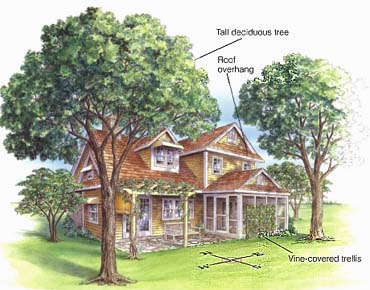|
Keeping your home cool during the heat of summer requires a multifaceted approach to maximize comfort and energy savings. About 25% of the summer heat that enters a house comes through the windows, another 25% seeps through cracks and 20% enters through walls and ceilings. Most of the rest is generated inside by cooking, bathing and heat-producing lights and appliances. For most homes, the first line of defense is air-conditioning, but these systems can be expensive to operate. To reduce energy costs, don’t rely on air-conditioning alone to make your home comfortable. Take the steps shown in the checklist at right to help keep the heat out. Air-conditioners cool, dehumidify and filter the air. They can be bought to condition a single room or the whole house. In areas where nights are cool and dry, a whole-house fan can cool a house at a fraction of the cost of air-conditioning. If you live in a dry climate, consider air conditioning your home with an evaporative cooler. These coolers use the natural process of water evaporation to cool indoor air at a fraction of the cost of refrigerated air. They contain a blower, fibrous pads, a small pump and a water reservoir. When the unit is operating, the pump draws water from the reservoir and distributes it to the pads to keep them saturated. The blower draws out side air through the pads to cool it, forcing the cooled air into the house and the warm, stale air out. |
 Above: Cooling with shade. Before air-conditioning, shade was the best defense against summertime heat. Today, shade has taken a back seat to the on-demand predictability and convenience of air-conditioning in homes, workplaces and cars. But don’t dismiss shading strategies as outdated; they will still provide plenty of comfort and energy savings. Shade can reduce your air-conditioning bill by as much as one-third and will make your yard cooler and more pleasant as well. The sun’s path dictates the best placement for shading devices. The west and south sides of a home are hardest hit by the summer sun. During the heat of the day, the south side takes the brunt of the sun’s rays. In the late afternoon and evening, when temperatures are highest, the west side becomes the victim. Landscape shading blocks the sun before it hits your house, so it’s a great house-cooling strategy. For maximum energy savings, place trees and other foliage so the house is shaded in summer but not in winter. Moderate-size trees block late morning and early evening sun. Tall trees placed fairly close to the house cast shade over the roof during midday hours. Energy-efficient roof design should include overhangs, awnings and porch roofs to shade the south walls and windows during the middle of the day. No one shading device or landscaping idea is best for every
home. But basic shading principles will help you choose what
fits your home’s style, your local climate and your budget.
|


